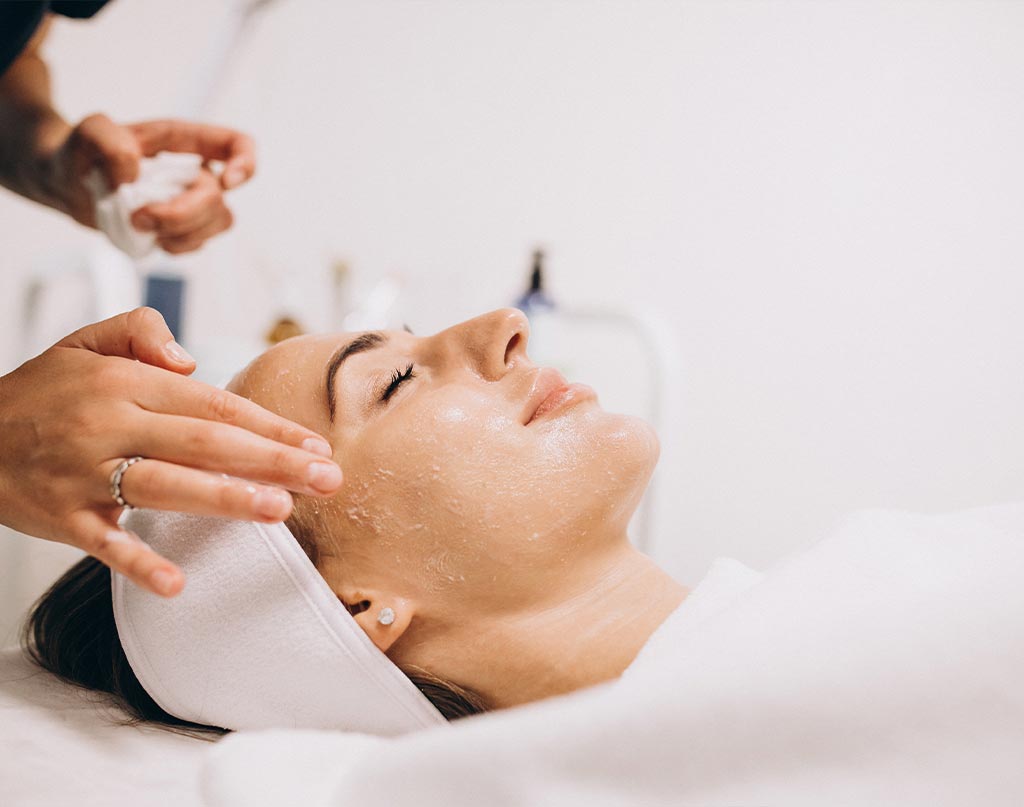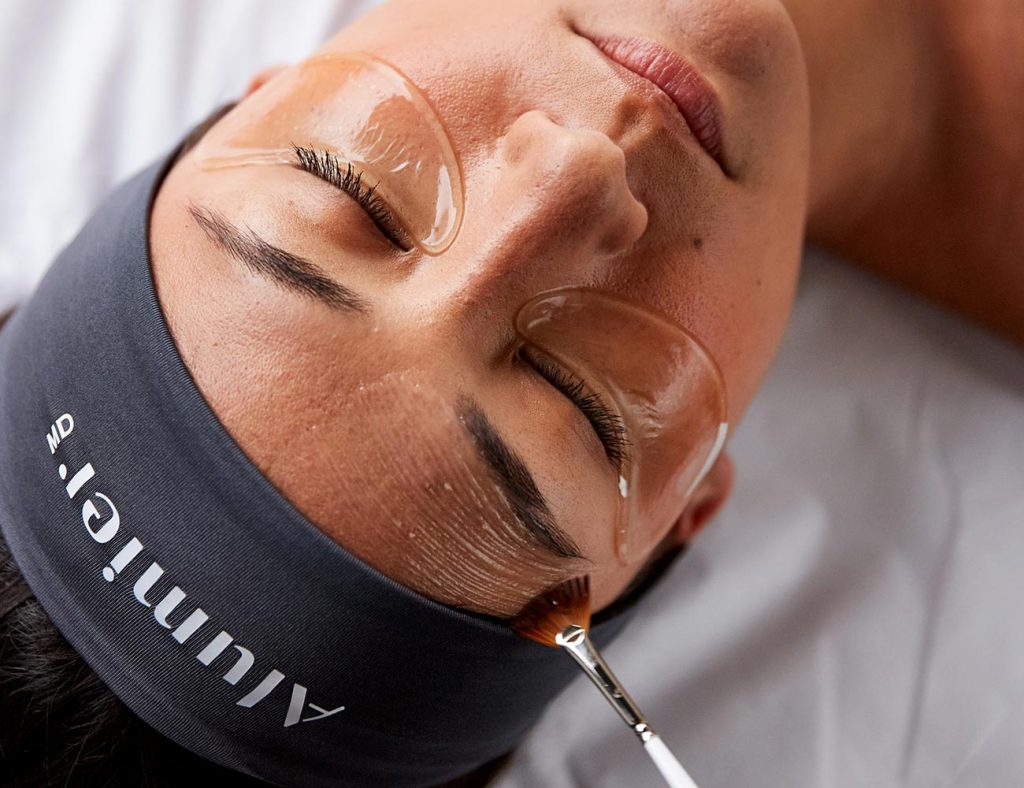CLINICAL TREATMENTS
Chemical Peel
What Are Chemical Peels?
A chemical peel is a treatment used to improve skin texture and tone. An acid is applied to skin to lower the pH, which loosens the connections between dead skin cells, inducing exfoliation and stimulating new cell growth. This process causes superficial layers of dead skin to peel off, revealing a smoother and more radiant complexion. Chemical peels can also thicken the epidermis, increase dermal volume and stimulate collagen.Chemical peels have been used dating back to Ancient Egypt. Cleopatra used sour milk to improve the appearance of her skin, according to some sources. Lactic acid (an alpha hydroxy acid) is the active ingredient in sour milk.


What Are Chemical Peels?
A chemical peel is a treatment used to improve skin texture and tone. An acid is applied to skin to lower the pH, which loosens the connections between dead skin cells, inducing exfoliation and stimulating new cell growth. This process causes superficial layers of dead skin to peel off, revealing a smoother and more radiant complexion. Chemical peels can also thicken the epidermis, increase dermal volume and stimulate collagen.Chemical peels have been used dating back to Ancient Egypt. Cleopatra used sour milk to improve the appearance of her skin, according to some sources. Lactic acid (an alpha hydroxy acid) is the active ingredient in sour milk.
How are chemical peels classified?
Chemical peels are classified as light (superficial), medium, or deep, depending on the depth of penetration of the ingredients used. Light peels exfoliate to various levels of the epidermis. Medium-depth peels treat through the papillary dermis and deep peels to the mid-reticular dermis. Deeper peels require more downtime and increase the chance of side effects, which include photosensitivity, pigment changes and scarring.
What is AlumierMD’s peel philosophy?
We offer light- to medium-depth peels known for their excellent results and safety profile. We believe in repeated treatments for progressive and gradual results, and to avoid the side effects and downtime associated with deeper peels. Chemical peels should be performed by a trained skin care professional in a clinical setting so that they are delivered safely and effectively.
Why should beneficial ingredients be applied post-peel and not within the peel solution?
Most beneficial ingredients for the skin tend to degrade or denature when placed in the low pH of chemical peel formulas. With that scientific information in mind, AlumierMD peels use only the pure acids; anti-aging, antioxidant and brightening booster ingredients are applied post-peel in our Brightening Accelerator keeping all components effective.
Peels remove the outer dead layers of the stratum corneum, so the booster ingredients are better absorbed when applied post-peel. Our multilayer process can be customized by your skin care professional according to your skin profile and concerns.
How Do They Work?
Chemical peels work by deeply exfoliating the surface layers of skin forcing your body to quickly replenish it with new cells. When peels are performed regularly, the skin gets used to this process and begins to rejuvenate itself like younger skin. To be sure that the body doesn’t react to this deep exfoliation as it would to trauma, which can lead to pigment changes, exfoliation must be introduced gradually giving the skin time to adjust.
As your skin care specialists, we will complete a thorough skin analysis and recommend an individualized treatment program to address your skin concerns. This will create a personalized program that combines professional treatments with home care products since they work synergistically to improve the health and beauty of skin. Pre-treatment products precondition the skin, accelerate results and minimize complications. Post-treatment products minimize complications, heal and soothe the skin and then maintain the results. Professional treatments enhance the results of your home care products.
Allure Medical Aesthetics
Where quality meets satisfaction every time. Join us and elevate your journey to new heights!
On what areas of the body are chemical peels used?
Chemical peels are usually performed on the face, but may also be used on the neck, décolleté and hands. How can chemical peels benefit the skin?
Peel treatments improve skin texture and firmness, decreasing fine lines and wrinkles. Peels also even out skin tone, improve acne-prone skin and reduce pore size appearance.
What are common peeling agents?
Some common peeling ingredients include alpha hydroxy acids, beta hydroxy acids, trichloroacetic acid (TCA) and retinol. Alpha hydroxy acids include glycolic acid (from sugar cane), lactic acid (from milk), citric acid (from oranges and lemons), malic acid (from apples and pears), tartaric acid (from grapes) and mandelic acid (from bitter almonds). Salicylic acid is the only beta hydroxy acid. The strength of a chemical peel is determined by the type of ingredients used, their concentrations and the pH of the formulation.
Not all peels are created equally, and one peel type doesn’t suit all. Certain ingredients may be more effective for treating acne, while others may be more successful in treating hyperpigmentation or the signs of aging. Book your chemical peel today and learn for yourself how wonderful this treatment is!

Preparation For A Peel Treatment:
It is best that you take the following into consideration:
- For best results and to reduce the risk of complications, it is recommended that you use Alumier MD home care products for 10-14 day prior to treatment
- If you are lactating, pregnant or may be pregnant, consult your physician or nurse practitioner before receiving any treatment
- Avoid sun exposure and tanning beds for at least two weeks prior to treatment
- Avoid the use of retinoid products (eg. retinol, Retin A, Tazorac) and levels of AHA and BHA products for approximately 7 days prior to treatment. Consult your physician or nurse practitioner before temporarily discontinuing the use of any prescription medications.
Will there be Downtime After the Peel?
AlumierMD skin treatments result in minimal to no downtime but create dramatic and visible results. Treatments may cause slight redness, tightness, peeling, flaking or temporary dryness. Most patients do not find it necessary to apply makeup, as the skin will be smooth, dewy and radiant following your treatment.
Post-Peel Skin Treatment Tips
You may experience some dryness and redness, but you may no peel. Some people peel and some do not. You may have light to moderate flaking for 3-7 days after the peel in localized areas.
- do not apply make up the day of the procedure (but you can the next day)
- use only the products provided to you in the Post Peel kit given to you; follow the instructions for 5-7 days after the peel
- Avoid sun exposure and excessive heat
- Do NOT cleanse your skin on the evening of your peel
- Do NOT pick or pull any flaking skin
- Do NOT tan or use a tanning booth for at least 14 days post peel
- Do NOT have electrolysis, waxing, threading or any other form of hair removal for 7 days post treatment
- Do NOT use facial scrubs or mechanical forms of exfoliation for 14 days after the peel
- Do NOT use retinol, AHA or BHA for 14 days post peel
- Do NOT have laser hair removal, photofacials, chemical peels or microdermabrasion for 14 days post peel
- Do NOT apply water or ice on the treated area
- Do NOT use hot tubs, steam rooms, suanas, and/or excessively hot showers for 2 days after a peel
- Do NOT go swimming for 2 days after a peel
- Do NOT participate in aerobic exercise for 2 days post peel
